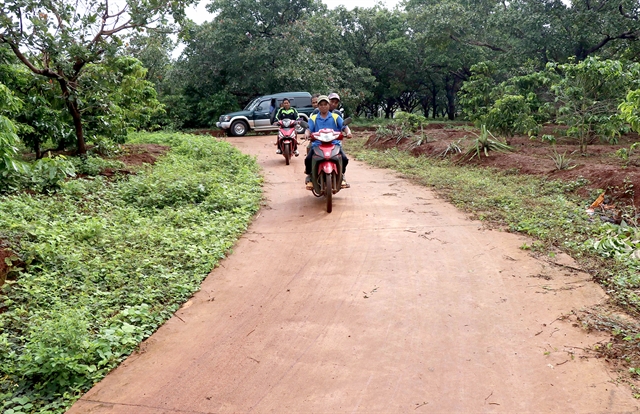 Society
Society

 |
| A concrete road in Nú Village of Ia Khai Commune, Ia Grai District. — VNA/VNS Photo Hồng Điệp |
GIA LAI — In order to build a new-style countryside, many people in remote, isolated and ethnic minority communes in the Tây Nguyên (Central Highlands) province of Gia Lai have become aware of the common interest and voluntarily donated their land to build roads, making their villages be more spacious rural areas.
Ksor Jinh, head of Myah Village, Ia Krái Commune of Ia Grai District, said that in the past, the village had only a small path which was very slippery in rainy season causing danger to people.
Now there are concrete roads to the village, Ksor Jinh said.
To build the road, Ksor Jinh donated 100 sq.m of land and mobilised villagers to hand over their land.
“At first, many households did not agree to donate land, but after analysing the common benefit for the community, they happily handed over their land,” said Ksor Jinh.
“There were three poor households who were willing to cut down dozens of coffee trees which were in the harvesting period,” he said.
Thanks to the land donation, three concrete roads with a total investment of VNĐ1.2 billion (US$50,000) were built connecting the difficult-to-reach village of Myah to the commune’s centre, which helps people travel more safely and transportation of agricultural products be more convenient.
Nú Village of Ia Khai Commune invested to build a 800m-long road thanks to donations of cashew gardens by the villagers.
Rơ Châm H'MonH, the village’s head, said that to hand over the land, people had to cut down 300 cashew trees which were bearing fruit.
At first, many people refused to do because these trees were large assets.
To set an example, he voluntarily cut down his 19 cashew trees in advance to donate land to build a road to the village.
However, for the community’s benefit, people were happy to donate their land, he said.
And after being persuaded many times, the villagers understood the interests of community and then agreed to donate land, he said.
Nguyễn Mai Lương, chairwoman of Ia Khai Commune, said that building roads to villages encroached on the cultivated land of the people so the authorities had to mobilise the villagers to donate land.
Up to now, Del Village of Ia Tô Commune has four roads with a total length of 2km thanks to people’s land donations.
According to Puih Glang, the village’s Party secretary, when making ground clearance for building roads, two households of Siu Giới and Puih Blung refused to dismantle 200m of fencing so the construction was stalled for months.
After being persuaded by the commune’s officials and villagers, they agreed to donate land.
Not only have they donated land, people of Del Village also contributed VNĐ400,000 ($15) per household for road construction, he said.
According to Lê Ngọc Quý, chairman of Ia Grai District, since the implementation of the National Target Programme on New Rural Development, the district’s Party Committee and Government have so far determined and mobilised the maximum participation of the whole political system, people, social organisations and business community.
Up to now, the road system in the district has basically met the travel demands that contribute to improving people's lives, he said.
Ia Grai district has developed a project to strengthen leadership and mobilise people to donate land to expand rural roads in the period of 2023 - 2025 with the aim of meeting the criteria of new rural development by 2025.
The district has set a plan to build at least 200km of rural roads to remote communes and villages by 2025.
Since 2020, the district has mobilised locals to donate land for building roads with a total area of more than 20,000 sq.m, of which the people of Ia Yok commune donated 4,000 sq.m and Ia O commune over 7,000 sq.m. — VNS